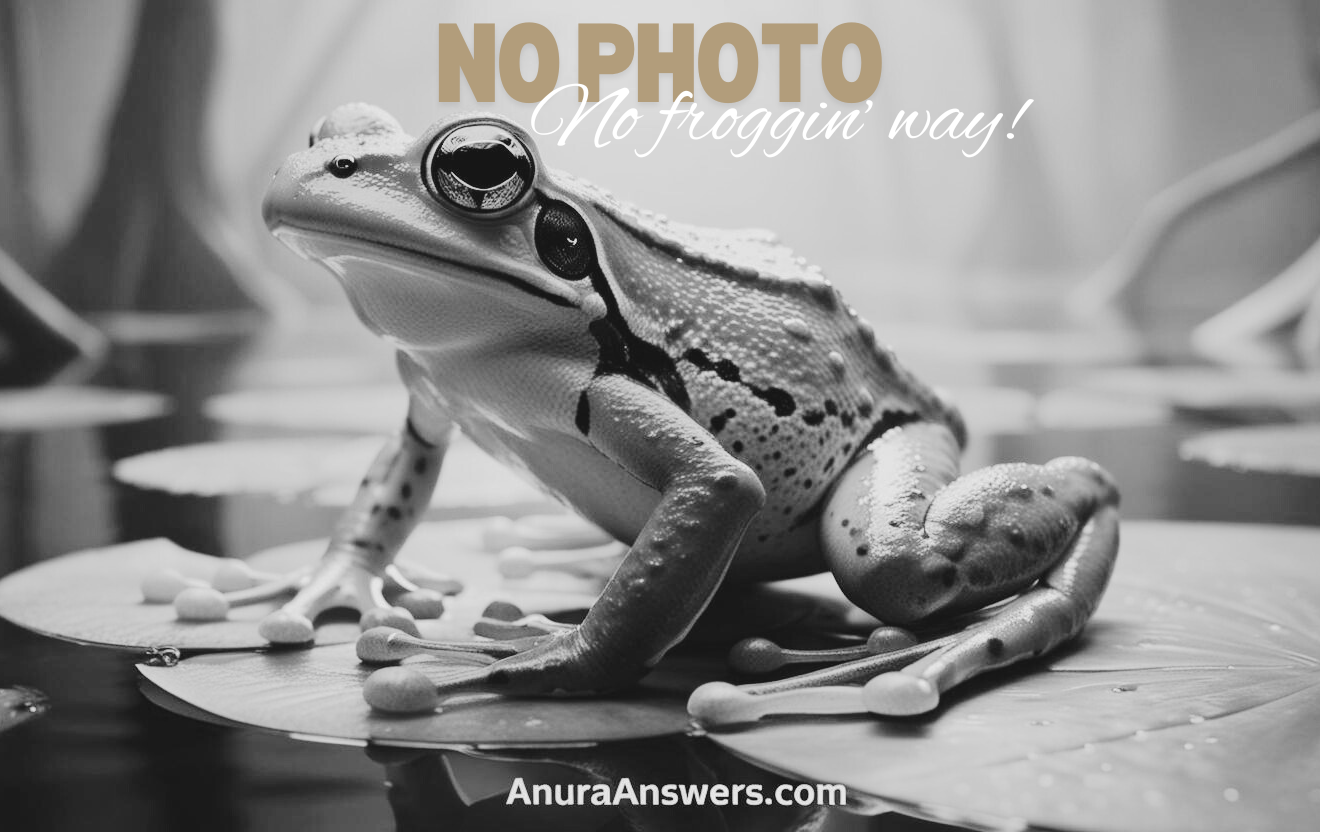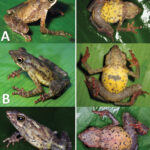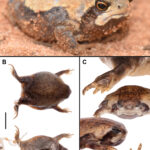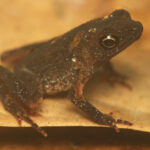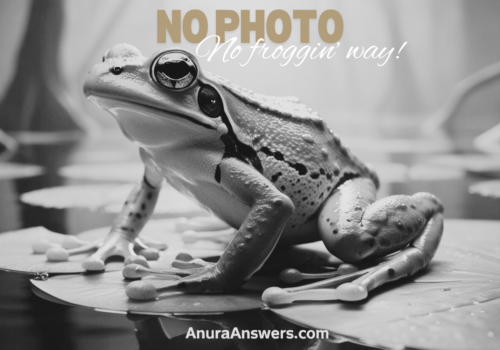- Unveiling the Wonders of the Marinkelle’s Harlequin Frog (Atelopus marinkellei): A Tale of Beauty, Survival, and Conservation
- Understanding Atelopus marinkellei: Taxonomy and Classification
- A Life Amidst Mist: The Habitat of Atelopus marinkellei
- A Vivid Display of Nature's Artistry: Physical Description
- Life Along the Stream: Behavior and Reproductive Ecology
- Ecological Significance: Indicators of Environmental Health
- Under Threat: Challenges Facing Atelopus marinkellei
- Beyond Biodiversity: Cultural and Scientific Contributions
- A Call for Conservation Action
Unveiling the Wonders of the Marinkelle’s Harlequin Frog (Atelopus marinkellei): A Tale of Beauty, Survival, and Conservation#
Hidden within the lush, cloud-shrouded Andean forests of Colombia lives a frog with an urgency in its quiet beauty. The Marinkelle’s Harlequin Frog (Atelopus marinkellei) is more than just a brilliant spectacle of colors and patterns; it embodies a delicate balance, a living testament to both nature’s artistry and the fragility of ecosystems under threat. Known for their stunning appearance—a dazzling tapestry of vivid patterns and vibrant hues—these amphibians have enthralled conservationists, researchers, and wildlife enthusiasts alike. Yet, beneath their striking exteriors lurks a cautionary tale, for they walk the fragile border between resilience and extinction.
Even among amphibian enthusiasts, Atelopus marinkellei stands out as an icon for conservation, an ambassador species highlighting the intricate complexity and unparalleled richness of Colombia’s biodiversity. Named in honor of renowned scientist and naturalist Cornelius Johannes Marinkelle, this captivating species captivates not only through its vibrant aesthetic but also through its profound ecological significance.
Understanding Atelopus marinkellei: Taxonomy and Classification#
The Marinkelle’s Harlequin Frog belongs to the amphibian order Anura, encompassing all frogs and toads. Within this extensive order, it is proudly placed into the Bufonidae family, commonly referred to as true toads. However, despite their family classification, members of the genus Atelopus, popularly known as harlequin frogs, defy common stereotypes of drab amphibians. Instead, they boast an impressive array of vibrant colorations that often signal their hidden toxicity to predators.
Within the genus Atelopus, comprising around 100 species, A. marinkellei shares close evolutionary ties with other widely recognized harlequin frogs such as Atelopus zeteki and Atelopus varius, both known for their striking appearance and alarming conservation status. Scientifically acknowledged in 1994, relatively little was known initially about A. marinkellei, yet its discovery quickly underscored the urgency to explore and conserve these incredible yet vulnerable species.
A Life Amidst Mist: The Habitat of Atelopus marinkellei#
At the northern extensions of the tropical Andes in Colombia, the habitat of A. marinkellei stretches along pristine high-altitude streams and montane forests. Tucked between elevations ranging typically from 1,800 to 2,500 meters, these frogs thrive in cloud forests rich in humidity and enveloped in persistent mist—an environment as mystical as it is biologically rich. Imagine a landscape where streams flow gently, flanked by ferns, moss-covered stones, and epiphyte-draped trees whose limbs catch moisture carried in cool mountain gusts.
This specific ecological niche is profoundly important, offering perfect temperatures and humidity, shelter under the dense canopy, and crystal-clear streams necessary for reproduction and survival. The abundant moisture and vegetation provide ample habitation for insects, a primary food source, ensuring the frog’s long-term sustenance. Moreover, the habitat of A. marinkellei is a delicate tapestry intricately woven across an ecosystem whose health profoundly influences the frog’s survival, and conversely, the species itself signals changes in habitat health.
A Vivid Display of Nature’s Artistry: Physical Description#
Measuring roughly 3 to 5 centimeters in length, Marinkelle’s Harlequin Frog may be small in stature but commands attention, for their bodies offer a dazzling display of nature’s painterly talents. Their skin boasts striking colors and complex patterns: vivid shades of vibrant yellows, deep blacks, striking orange, and occasional tinges of green form geometric patterns reminiscent of abstract artwork.
These exceptional colorations serve as a bold warning—nature’s attention-grabbing caution sign. Their bright colors illustrate aposematic coloration, signaling a hidden potency to potential predators. Indeed, like many harlequin frogs, A. marinkellei possesses toxins in its skin, a defensive development essential to surviving amidst myriad predators within its lush yet perilous habitat.
Their agile slender limbs and delicate digits, adapted for terrestrial living along streams, equip them superbly for precision jumping and gripping onto slippery rocks during mating or predation avoidance. Every aspect of their physical design is intentional, and intricately fine-tuned over thousands of years—adapted perfectly to the mountain streams and dense foliage that form their home.
Life Along the Stream: Behavior and Reproductive Ecology#
A. marinkellei spends its entire existence closely tied to the clear mountain streams lining its forest home. Like dainty acrobats, these frogs navigate the slick rocks and vegetation with precision and grace. Primarily diurnal, they reveal their vivid colors openly during daylight, relying on visual cues to communicate intentions to potential mates or rivals.
Feeding Habits and Diet#
The diet of these frogs primarily consists of small insects and arthropods abundant in their misty habitats. Using their lightning-fast reflexes, they employ swift yet deliberate strike tactics, seizing prey quickly from hiding places in moss-covered rocks and leaf litter. In doing so, they play a crucial ecological role, helping regulate insect populations, thus maintaining equilibrium within the ecosystem.
Mating and Breeding Cycle#
Each year, aligned with rainy season peaks that transform trickling streams into vibrant waterways, the frogs gather in communal breeding areas. Male frogs issue diverse, melodious calls—subtle yet profound notes carrying echoes through misty air—to attract females. Once paired, females deposit numerous gelatinous clusters of eggs directly into the swiftly moving streams, securing their offspring’s immediate access to fresh, oxygen-rich waters. Tadpoles hatch and develop submerged within these pristine environments, completing metamorphosis into vivid juvenile frogs, ready to continue their vital ecological roles.
Ecological Significance: Indicators of Environmental Health#
The presence of Marinkelle’s Harlequin Frog signals much more than spectacular biodiversity; these amphibians serve as critical bioindicators. Amphibians, particularly the Atelopus genus, have highly permeable skins that make them exceptionally sensitive to environmental disturbances. Their health and survival directly reflect overall ecosystem integrity.
Moreover, as predators within their trophic level, they maintain insect and arthropod populations, ensuring healthy functioning ecosystems. Concurrently, their toxin-bearing protective skins demonstrate a sophisticated evolutionary relationship with native predators and cohabiting species—an ecological dance maintained by balance and behavioral adaptations developed over millennia.
Under Threat: Challenges Facing Atelopus marinkellei#
Despite nature’s delicate yet resolute craftsmanship, Marinkelle’s Harlequin Frogs face severe threats. Widely recognized globally for their vulnerability, harlequin frogs have declined dramatically in recent decades due primarily to habitat loss, climate change, and the devastating emergence of chytridiomycosis—a lethal fungal disease caused by Batrachochytrium dendrobatidis (Bd).
Current Conservation Efforts and IUCN Status#
According to the IUCN Red List, Atelopus marinkellei is currently classified as Critically Endangered. Thankfully, conservation strategies emphasizing habitat preservation, disease mitigation, and breeding programs have begun in earnest, promising renewed hope. Colombian environmental organizations and international institutions advocate tirelessly to preserve critical forest habitats, conduct disease research, and establish ex-situ conservation breeding programs, carefully rebuilding populations and safeguarding this precious species for future generations.
Beyond Biodiversity: Cultural and Scientific Contributions#
Within Colombia’s rich cultural tapestry, amphibians like A. marinkellei symbolize nature’s balance and cultural heritage carried forward through generations. Scientifically, these frogs provide valuable insights into amphibian biology, ecology, and impacts of environmental threats, reinforcing their role not just as biological treasures but as essential study subjects in conservation biology.
A Call for Conservation Action#
Marinkelle’s Harlequin Frog is undeniably captivating, serving as a profound reminder of ecological interconnectedness and vulnerability. Their existence challenges us to reflect upon our ecological responsibilities, prompting greater awareness, advocacy, and proactive conservation engagement. By protecting their habitats and championing conservation efforts, we foster hope—ensuring future generations witness the living artistry of Atelopus marinkellei, and ensuring Earth’s magnificent diversity persists.
Let this beautiful amphibian remind us always of nature’s profound worth and inspire us boldly to lend our voices and actions for their precious survival.
